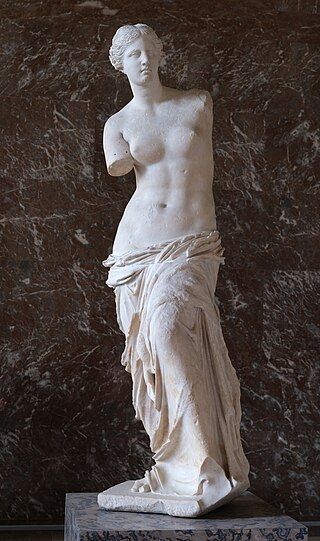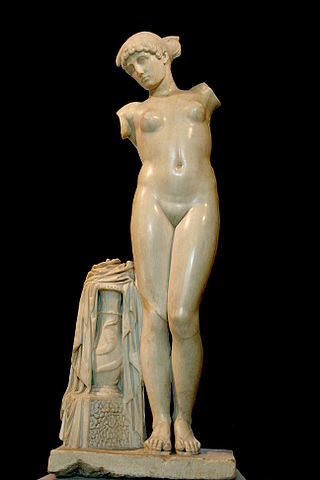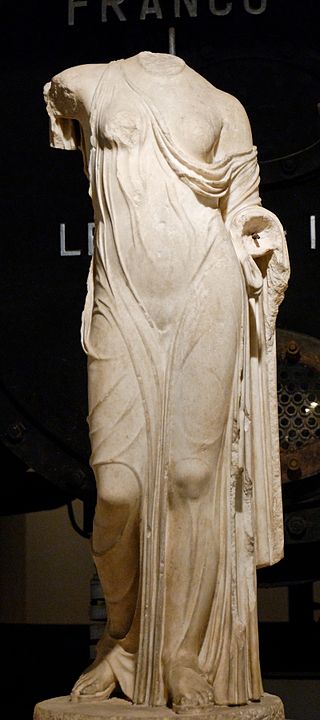
Venus is a Roman goddess whose functions encompass love, beauty, desire, sex, fertility, prosperity, and victory. In Roman mythology, she was the ancestor of the Roman people through her son, Aeneas, who survived the fall of Troy and fled to Italy. Julius Caesar claimed her as his ancestor. Venus was central to many religious festivals, and was revered in Roman religion under numerous cult titles.

The Venus de Milo or Aphrodite of Melos is an ancient Greek marble sculpture that was created during the Hellenistic period. Its exact dating is uncertain, but the modern consensus places it in the 2nd century BC, perhaps between 160 and 110 BC. It was rediscovered in 1820 on the island of Milos, Greece, and has been displayed at the Louvre Museum since 1821. Since the statue's discovery, it has become one of the most famous works of ancient Greek sculpture in the world.

Praxiteles of Athens, the son of Cephisodotus the Elder, was the most renowned of the Attic sculptors of the 4th century BC. He was the first to sculpt the nude female form in a life-size statue. While no indubitably attributable sculpture by Praxiteles is extant, numerous copies of his works have survived; several authors, including Pliny the Elder, wrote of his works; and coins engraved with silhouettes of his various famous statuary types from the period still exist.

The Galleria Borghese is an art gallery in Rome, Italy, housed in the former Villa Borghese Pinciana. At the outset, the gallery building was integrated with its gardens, but nowadays the Villa Borghese gardens are considered a separate tourist attraction. The Galleria Borghese houses a substantial part of the Borghese Collection of paintings, sculpture and antiquities, begun by Cardinal Scipione Borghese, the nephew of Pope Paul V. The building was constructed by the architect Flaminio Ponzio, developing sketches by Scipione Borghese himself, who used it as a villa suburbana, a country villa at the edge of Rome.

Scipione Caffarelli-Borghese was an Italian cardinal, art collector and patron of the arts. A member of the Borghese family, he was the patron of the painter Caravaggio and the artist Bernini. His legacy is the establishment of the art collection at the Villa Borghese in Rome.

The Aphrodite of Knidos was an Ancient Greek sculpture of the goddess Aphrodite created by Praxiteles of Athens around the 4th century BC. It was one of the first life-sized representations of the nude female form in Greek history, displaying an alternative idea to male heroic nudity. Praxiteles' Aphrodite was shown nude, reaching for a bath towel while covering her pubis, which, in turn leaves her breasts exposed. Up until this point, Greek sculpture had been dominated by male nude figures. The original Greek sculpture is no longer in existence; however, many Roman copies survive of this influential work of art. Variants of the Venus Pudica are the Venus de' Medici and the Capitoline Venus.

Giovanni Francesco (Gianfrancesco) Susini was a Mannerist Florentine sculptor in bronze and marble.

Venus Anadyomene is one of the iconic representations of the goddess Venus (Aphrodite), made famous in a much-admired painting by Apelles, now lost, but described in Pliny's Natural History, with the anecdote that the great Apelles employed Campaspe, a mistress of Alexander the Great, for his model. According to Athenaeus, the idea of Aphrodite rising from the sea was inspired by the courtesan Phryne, who, during the time of the festivals of the Eleusinia and Poseidonia, often swam nude in the sea. A scallop shell, often found in Venus Anadyomenes, is a symbol of the female vulva.

The Venus de' Medici or Medici Venus is a 1.53 m tall Hellenistic marble sculpture depicting the Greek goddess of love Aphrodite. It is a 1st-century BC marble copy, perhaps made in Athens, of a bronze original Greek sculpture, following the type of the Aphrodite of Knidos, which would have been made by a sculptor in the immediate Praxitelean tradition, perhaps at the end of the century. It has become one of the navigation points by which the progress of the Western classical tradition is traced, the references to it outline the changes of taste and the process of classical scholarship. It is housed in the Uffizi Gallery, Florence, Italy.

The Borghese Collection is a collection of Roman sculptures, old masters and modern art collected by the Roman Borghese family, especially Cardinal Scipione Borghese, from the 17th century on. It includes major collections of Caravaggio, Raphael, and Titian, and of ancient Roman art. Cardinal Scipione Borghese also bought widely from leading painters and sculptors of his time, and Scipione Borghese's commissions include two portrait busts by Gian Lorenzo Bernini. Most of the collection remains intact and on display at the Galleria Borghese, although a significant sale of classical sculpture was made under duress to the Louvre in 1807.

Pauline Bonaparte as Venus Victrix is a semi-nude life-size reclining neo-Classical portrait sculpture by the Italian sculptor Antonio Canova. Reviving the ancient Roman artistic traditions of portrayals of mortal individuals in the guise of the gods, and of the beautiful female form reclining on a couch, it was commissioned by Pauline Bonaparte's husband Camillo Borghese and executed in Rome from 1805 to 1808, after the subject's marriage into the Borghese family. It then moved to Camillo's house in Turin, then to Genoa, only arriving in its present home around 1838.

The Sleeping Hermaphrodite is an ancient marble sculpture depicting Hermaphroditus life size. In 1620, Italian artist Gian Lorenzo Bernini sculpted the mattress upon which the statue now lies. The form is partly derived from ancient portrayals of Venus and other female nudes, and partly from contemporaneous feminised Hellenistic portrayals of Dionysus/Bacchus. It represents a subject that was much repeated in Hellenistic times and in ancient Rome, to judge from the number of versions that have survived. Discovered at Santa Maria della Vittoria, Rome, the Sleeping Hermaphrodite was immediately claimed by Cardinal Scipione Borghese and became part of the Borghese Collection. The "Borghese Hermaphrodite" was later sold to the occupying French and was moved to The Louvre, where it is on display.

The Capitoline Venus is a type of statue of Venus, specifically one of several Venus Pudica types, of which several examples exist. The type ultimately derives from the Aphrodite of Cnidus. The Capitoline Venus and her variants are recognisable from the position of the arms—standing after a bath, Venus begins to cover her breasts with her right hand, and her groin with her left hand.

The Esquiline Venus is a smaller-than-life-size Roman nude marble sculpture of a female in sandals and a diadem headdress. There is no definitive scholarly consensus on either its provenience or its subject. It is widely viewed as a 1st-century CE Roman copy of a Hellenistic original from the 1st-century BCE Ptolemaic Kingdom, commissioned by emperor Claudius to decorate the Horti Lamiani.

The Crouching Venus is a Hellenistic model of Venus surprised at her bath. Venus crouches with her right knee close to the ground, turns her head to the right and, in most versions, reaches her right arm over to her left shoulder to cover her breasts. To judge by the number of copies that have been excavated on Roman sites in Italy and France, this variant on Venus seems to have been popular.

The Ares Borghese is a Roman marble statue of the imperial era. It is 2.11 metres high. Though the statue is referred to as Ares, this identification is not entirely certain. This statue possibly preserves some features of an original work in bronze, now lost, of the 5th century BC.

The Venus Genetrix is a sculptural type which shows the Roman goddess Venus in her aspect of Genetrix, as she was honoured by the Julio-Claudian dynasty of Rome, which claimed her as their ancestor. Contemporary references identify the sculptor as a Greek named Arcesilaus. The statue was set up in Julius Caesar's new forum, probably as the cult statue in the cella of his temple of Venus Genetrix. Through this historical chance, a Roman designation is applied to an iconological type of Aphrodite that originated among the Greeks.

The Venus of Arles is a 1.94-metre-high (6.4 ft) sculpture of Venus at the Musée du Louvre. It is in Hymettus marble and dates to the end of the 1st century BC.
The Hera Borghese is a type of sculpture of Hera named after the owners of its archetype, the Borghese family.
Alain Pasquier is a French art historian specialising in ancient Greek art, museography and conservation.


















